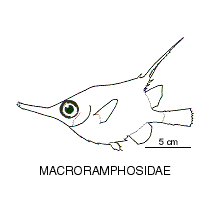- Classification
- ACTINOPTERYGII
- SYNGNATHIFORMES
- MACRORAMPHOSIDAE
-
Fish Classification
-
Class
ACTINOPTERYGII Ray-finned fishes -
Order
SYNGNATHIFORMES Seahorses, pipefishes -
Family
MACRORAMPHOSIDAE Bellowfishes
Family MACRORAMPHOSIDAE
More Info
|
Family Taxonomy |
A small family with 3 described genera, 2 of which are restricted to the Southern Hemisphere. Although there are 9 described species, the family may comprise more species than are currently recognised. Five species in 3 genera occur in Australian waters. |
|
Family Distribution |
Circumglobal in temperate and tropical waters on the continental shelf and slope. Bellowsfishes are benthic or bentho-pelagic over rocky, sandy, muddy or detritus bottoms, at depths between 46–1000 m. Some species form schools above the seafloor. Juveniles are pelagic. |
|
Family Description |
Meristics: D IV-VII, 9-11; A 19-20; P 15; V I, 4 C 23; Vert 24; BR 4-5 Circumorbital bones 1 Head and body highly compressed, moderately deep to very deep, almost circular in shape. Snout slender, elongate, mouth tiny, teeth absent. First or second dorsal-fin spine long, stout, pointed; soft dorsal fin and caudal fin displaced ventrally on body; pelvic fins small. Sides of body covered in granular scales resulting in a sandpaper-like texture; bony body plates present. Lateral line absent. |
|
Family Size |
Bellowfishes grow to more than 30 cm in length. |
|
Family Colour |
Bellowsfishes are usually orange, red or brownish in colour, and some species are banded. |
|
Family Feeding |
Bellowsfishes are carnivores and feed on zooplankton, benthic fauna including crustaceans and echinoderms, and small fishes. Prey items are sucked in through the long snout. |
|
Family Reproduction |
The sexes are separate, and fertilisation is external. The eggs are spherical with a single oil droplet and rose-violet coloured yolk. Larvae and small juveniles are pelagic. They are lightly pigmented, and develop body spinules at a length of 6 mm. Small juveniles are pelagic. |
|
Family Commercial |
Although of no real commercial importance, some species are taken in large numbers as bycatch in commercial bottom trawls. Some species are sold in the aquarium industry. |
|
Family Conservation |
Not evaluated. |
References
Bilecenoglu, M. 2006. Status of the genus Macroramphosus (Syngnathiformes: Centriscidae) in the eastern Mediterranean Sea. Zootaxa 1273: 55–64.
Borges, L. 2001. A new maximum length for the snipefish Macrocramphosus scolopax. Cybium 25(2): 191-192.
Clarke, T.A. 1984. Diet and morphological variation in snipefishes, presently recognized as Macrorhamphosus scolopax, from southeast Australia: evidence for two sexually dimorphic species. Copeia 1984(3): 595-608.
Duhamel, G. 1995. Révision des genres Centriscops et Notopogon, Macroramphosidae des zones subtropicale et tempérée de l'hémisphère sud. Cybium 19(3): 261-303.
Fritzsche, R.A. & K.G. Thiesfeld. 1999. Centricidae, in Carpenter, K.E. & V.H. Niem. 1999. Species identification guide for fisheries purposes. The living marine resources of the western central Pacific. Bony fishes part 2 (Mugilidae to Carangidae). FAO, Rome.
Gomon, M.F. 2008. Family Macrorhamphosidae (p. 480-484). In Gomon, M.F., D.J. Bray & R.H. Kuiter. (Eds.) Fishes of Australia's Southern Coast. Reed New Holland, Chatswood, Australia, 928 pp.
Kuiter, R. H. 2009. Seahorses and their relatives. Aquatic Photographics, Seaford, Australia. 333 pp.
May, J.L. & J.G.H. Maxwell. 1986. Trawl fish from temperate waters of Australia. CSIRO Division of Fisheries Research, Tasmania. 492 p.
Miyazaki, E., Sasaki, K., Mitani, T., Ishida, M. & Uehara, S. 2004. The occurrance of two species of Macroramphosus (Gasterosteiformes: Macroramphosidae) in Japan: morphological and ecological observation on larvae, juveniles and adults. Ichthyol. Res. 51: 256-262.
Mohr, E. 1937. Revision der Centriscidae (Acanthopterygii Centrisciformes). Dana Rept. 13: 1-69, figs. 1-33 pls. 1-2
Nelson, J.S. 2006. Fishes of the world. 4th Ed. Wiley and Sons, New York, 601 p.
Paulin, C., A. Stewart, C. Roberts and P. McMillan, 1989 New Zealand fish: a complete guide. National Museum of New Zealand Miscellaneous Series No. 19. xiv+279 p
Paxton, J.R., J.E. Gates & D.F. Hoese. 2006. Gasterosteiformes, In Beesley, P.L. & A. Wells (Eds). Zoological catalogue of Australia. Volume 35 Fishes. ABRS & CSIRO Publishing, Australia. Part 2.
Regan, C.T. (1914). Diagnoses of new marine fishes collected by the British Antarctic Terra Nova Expedition. Ann. Mag. Nat. Hist. (8) 13(2): 11-17.
Smith, M.M. & P.C. Heemstra. 1986. (eds.) Smiths' Sea Fishes. Macmillan South Africa.
Watson, W., 1996 Centriscidae: snipefishes and shrimpfishes. p. 725-727. In H.G. Moser (ed.) The early stages of fishes in the California Current Region. California Cooperative Oceanic Fisheries Investigations (CalCOFI) Atlas No. 33. Allen Press, Inc., Lawrence, Kansas. 1505 pp.



















